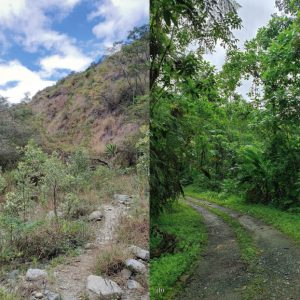Heliconius erato cyrbia (Wikimedia Commons)
Heliconius himera (Butterflies of America)
With the climate crisis ravaging our planet, it is crucial to understand how animal behavior adapts to changing environmental conditions. Although not always the result of climate change, new ecological or geographical barriers can cause the divergence of species. Divergence is the process by which a closely-related species diverge into separate descendant species that differ in characteristics, ultimately resulting in speciation. In “Shifting balances in the weighting of sensory modalities are predicted by divergence in brain morphology in incipient species of Heliconius butterflies” by Denise Dell’Aglio, Owen McMillan, and Stephen Montgomery, Heliconius erato cyrbia and Heliconius himera are separated by an ecological gradient in the Ecuadorian Andies with differing environmental conditions (“spanning from the lowland wet rain forest to high altitude dry forest”).

“Butterflies’ natural environments in southern Ecuador. (a) Dry forest in Vilcabamba, H. himera range. (b) Evergreen wet forest in Piñas, Jocotoco Buenaventura Reserve, H. erato cyrbia range.”
The two species of Heliconius butterflies are parapatric closely related species, meaning that they are spread out over a large geographic area and have undergone reproductive isolation. Via this divergence, the butterflies have developed differences in brain morphology within their sensory regions that ultimately impact their foraging behavior. Lepidopterans (the insect order that includes butterflies and moths) “utilize several sensory modalities in flower selection, but there is a preference hierarchy”. Due to their differences in brain morphology, Heliconius erato cyrbia relies more on their visual centers whereas Heliconius himera relies more on their olfactory centers. This may suggest that the species diverged due to the “emphasis placed on these different sensory domains during foraging” which may be consistent with the demands and climates of their different environments. The wet forest contains large-leaved tree species resulting in a dense canopy and higher annual rainfall. The dry forest has small-leaved tree species and low annual precipitation as well as lower temperatures. This transition of environments caused investment in different regions of the brain between the incipient species and “reflect adaptive functional changes in sensory processing to match their divergent environments”.

Parapatric Speciation (Wikimedia Commons)
In this study, Dell’Aglio et al. hypothesized that “divergence in sensory brain regions affects foraging decisions”. They predicted that the divergence the two species had undergone would impact the emphasis they put on olfactory and visual information. For the experiment, populations of Heliconius erato cyrbia and Heliconius himera were obtained from Ecuador via the insectaries at the Smithsonian Tropical Research Institute, Gamboa, Panama. The butterflies were split into groups of five and subjected to food deprivation overnight in order to perform experiments early in the morning. The visual stimuli were orange, red, or pink (colors easily distinguished by Heliconius butterflies) artificial flowers made out of foam sheets. The solutions placed in the flowers “were sugar water for the positive reward and water with vitamin C for the negative reinforcer” (as it is a deterrent in Lepidopterans). For the odor learning experiment, lemongrass and orange fruit were used as odor sources. For the conflict experiment, a separate group of both butterfly species were presented with a combination of visual and olfactory stimuli (“the positively reinforced combination was the pink feeder and lemongrass odor, with the orange feeder and orange odor being negatively reinforced”). The experiments were all recorded via an action camera. Both species showed learning behaviors as they changed their preference for flower color depending on the substance inside (sugar water was preferred). However, H. himera was able to discriminate and choose the positively reinforced color significantly more, starting immediately from the second day whereas H. e. cyrbia continued to show a preference for the negatively reinforced color. The “two species did not have any bias towards either odor” and didn’t differ in their learning rate of associating the odor with a positive reward. Both species “behaved equally when learning an association between the odor plus color combination and food reward”. A different behavioral response was observed however, when positively reinforced odor was presented with color. H. e. cyrbia showed a strong preference towards the color association even when the negative reinforcement odor was introduced. However, in H. himera, the number of feeding attempts decreased in the absence of the positive reinforcement odor. In addition, “preference towards the positively reinforced colour was no longer significantly different from chance when presented with the negatively reinforced odor”.
It is safe to conclude that H. himera prioritizes the olfactory component of the combined experiment (color and odor) more than H. e. cyrbia. Despite the close relationship between Heliconius erato cyrbia and Heliconius himera their integration of olfactory and visual stimuli has diverged, made evident through differences in their brain morphology. These results are consistent with the environmental conditions each of these species reside in. In the home range of Heliconius erato cyrbia most flowers are orange, whereas the home range of Heliconius himera of has a greater range of flower colors. In the conflict experiments, when forcibly making a choice between odor and color, Heliconius erato cyrbia relied mostly on vision which is consistent with their diurnal nature. On the other hand, Heliconius himera favored the positively reinforced odor over the positively reinforced color. This is an example of a multimodal preference change, which has been noted in other butterfly species where color preference is demonstrated in the presence of the odor but not in the absence. The results were also consistent with the butterflies’ brain morphology. H. himera has large antennal lobes which is the “primary olfactory neuropil” whereas H. e. cyrbia has “higher investment in the medulla and lobula, which have specific roles in processing visual information”.
There has been little research “done on how these multimodal preferences evolve, particularly among such closely related species.” It is crucial that further combinations of color and odor cues be explored in order to better understand the multimodal preference of Heliconius butterflies when it comes to visual vs. olfactory stimuli during foraging. Speciation will be greatly impacted by climate change and it is crucial to understand the adaptations made by animals when undergoing environmental transitions. This can provide further insight into how brain anatomy and animal behavior are impacted by divergence.
Citation:
Dell’Aglio, Denise D., et al. “Shifting Balances in the Weighting of Sensory Modalities Are Predicted by Divergence in Brain Morphology in Incipient Species of Heliconius Butterflies.” Animal Behaviour, Academic Press, 4 Feb. 2022, https://www.sciencedirect.com/science/article/pii/S0003347222000033.
